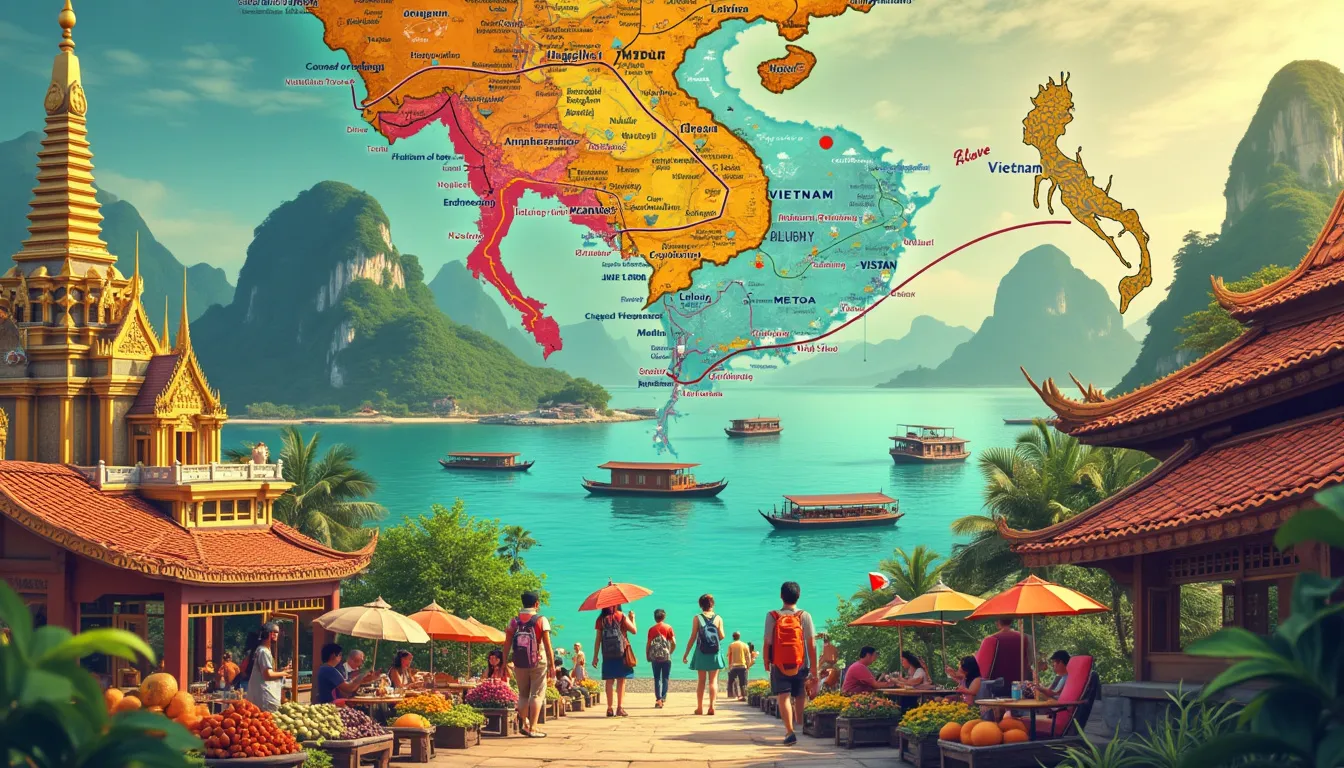Embarking on a journey from Thailand to Vietnam unveils a tapestry of rich cultures, stunning landscapes, and unforgettable experiences. Whether you’re soaring through the skies or traversing the scenic overland paths, this travel guide is designed to ensure your trip is as seamless and enriching as possible. From convenient flights departing from Thailand’s bustling cities to adventurous bus and train routes that offer unparalleled glimpses of Southeast Asia’s heartland, the travel options are diverse and plentiful. As you plan your itinerary, we’ll guide you through the must-see destinations across these two captivating countries. From the magnificent temples and vibrant markets of Thailand to the historical landmarks and breathtaking natural beauty of Vietnam, each stop promises to deepen your appreciation for this vibrant region. Let us take you on an inspiring journey from Thailand to Vietnam, highlighting the best routes and key attractions that will make your adventure truly memorable.
Best Routes for Traveling from Thailand to Vietnam
If you’re gearing up for an adventure from Thailand to Vietnam, it’s essential to plan your journey efficiently. Both countries offer an array of stunning landscapes, rich cultures, and historical landmarks. Here’s a look into the best routes for traveling from Thailand to Vietnam.
Flights from Major Thai Cities
When considering the quickest and most convenient way to traverse from Thailand to Vietnam, flights are the standout option. Here’s a breakdown of flight options from major Thai cities:
Bangkok to Ho Chi Minh City
Bangkok, being the largest city and the capital of Thailand, serves as a central hub for numerous international flights. Regular flights from Bangkok to Ho Chi Minh City are available through several airlines such as Thai Airways, Vietnam Airlines, and low-cost carriers like AirAsia. The flight duration is approximately 1.5 hours, making it the fastest route to start your Vietnamese adventure. Flights are frequent, and you can often find good deals if you book in advance.
Bangkok to Hanoi
Another popular route is from Bangkok to Hanoi, Vietnam’s capital city. Airlines like Thai Airways, Vietnam Airlines, and VietJet Air operate multiple flights daily. The flight duration is about 2 hours, making it a quick and convenient option for travelers. Just like the route to Ho Chi Minh City, booking in advance can lead to better fares.
Chiang Mai to Vietnam
For travelers based in Northern Thailand, Chiang Mai serves as a vital departure point. Direct flights from Chiang Mai to Hanoi and Ho Chi Minh City are available, primarily operated by VietJet Air and AirAsia. The flight times are slightly longer compared to flights from Bangkok; however, the convenience of flying directly from Chiang Mai makes this an attractive option.
Overland Travel Options: Buses and Trains
For those who prefer a more scenic journey or are on a budget, overland travel from Thailand to Vietnam offers an unforgettable experience. Here are the key overland routes:
Buses from Bangkok to Ho Chi Minh City
Traveling by bus is one of the most economical ways to make the journey from Thailand to Vietnam. Bus companies like The Sinh Tourist and Hoang Long offer routes from Bangkok to Ho Chi Minh City. The trip typically involves crossing into Cambodia before entering Vietnam, which can take between 24 to 30 hours, depending on the duration of border procedures. While the journey is long, it provides an opportunity to see the countryside and interact with other travelers.
Buses from Chiang Mai to Hanoi
Traveling by bus from Chiang Mai to Hanoi is less common due to the distance and the multiple border crossings involved. Typically, this journey requires taking a bus to the border town, like Chiang Rai, proceeding into Laos, and then continuing to Vietnam. It’s a long haul, usually taking two or more days, but it’s a fascinating route for intrepid travelers looking to immerse themselves in the landscapes of three different countries.
Trains from Bangkok to Hanoi
Train travel can be a more relaxed way to experience the journey from Thailand to Vietnam. Though there is no direct train from Bangkok to Hanoi, travelers can combine train and bus travel. Start by taking the train from Bangkok to the border town of Nong Khai, then proceed by crossing the Friendship Bridge to Thanaleng Station in Laos. From there, take a bus or train to Hanoi. This route showcases diverse sceneries and offers a laid-back travel experience.
Another popular train route involves traveling from Bangkok to Phnom Penh, Cambodia. From Phnom Penh, you can catch a bus or another train to Ho Chi Minh City, Vietnam. Though more time-consuming, it allows for multiple stops along the way, offering an enriching experience as you journey across different regions.
In conclusion, whether you prefer the comfort and speed of flights or the adventure and savings of overland travel, there are multiple routes available when traveling from Thailand to Vietnam. Each option provides unique experiences and perspectives, allowing you to choose the one that best fits your travel style and objectives.

II. Must-See Destinations When Traveling from Thailand to Vietnam
Embarking on a journey from Thailand to Vietnam presents an opportunity to explore two of Southeast Asia’s most captivating countries. This section will delve into the quintessential destinations in both Thailand and Vietnam that should not be missed. These attractions showcase the rich cultural, historical, and natural beauty of these nations, ensuring an unforgettable travel experience.
A. Key Attractions in Thailand
When traveling from Thailand to Vietnam, the vibrant destinations within Thailand set a remarkable stage for your journey. Thailand offers a tapestry of experiences, from bustling cities to serene beaches and historical landmarks.
Bangkok
The capital city of Bangkok is an essential stop for anyone traveling in Thailand. This sprawling metropolis is known for its ornate temples, bustling markets, and vibrant nightlife. A visit to the Grand Palace, Wat Phra Kaew, and Wat Arun provides a glimpse into the country’s rich history and architectural splendor. For a taste of local life, explore the famous Chatuchak Weekend Market or take a boat ride along the Chao Phraya River. Bangkok’s culinary scene is equally enticing, with street food stalls lining the streets and high-end restaurants offering delectable Thai cuisine.
Chiang Mai
Nestled in the mountainous region of Northern Thailand, Chiang Mai is known for its picturesque scenery, ancient temples, and cultural festivals. The historic Old City, surrounded by remnants of ancient walls and moats, houses over 30 temples, including Wat Phra Singh and Wat Chedi Luang. Chiang Mai is also a gateway to ethnic minority villages and stunning natural attractions such as Doi Suthep-Pui National Park. The city is famed for its night bazaar and the Yi Peng Lantern Festival, where the night sky is illuminated by thousands of floating lanterns.
Phuket
Phuket, Thailand’s largest island, is synonymous with stunning beaches, luxury resorts, and vibrant nightlife. Patong Beach is famous for its lively atmosphere, water sports, and bustling Bangla Road filled with entertainment venues. For a tranquil escape, head to Kata or Karon beaches. Adventure seekers can explore the Similan Islands, renowned for their diving spots, or take a boat trip to the iconic James Bond Island. Phuket’s Old Town, with its Sino-Portuguese architecture and colorful shophouses, offers a charming contrast to the island’s beach life.
B. Top Tourist Spots in Vietnam
As your journey transitions from Thailand to Vietnam, you’ll encounter an array of dazzling destinations that highlight Vietnam’s unique charm and diversity. From bustling cities to serene landscapes, Vietnam is packed with must-see spots.
Hanoi
Vietnam’s capital, Hanoi, is a blend of ancient history and contemporary bustle. The Old Quarter, with its narrow streets and colonial architecture, is the perfect place to start exploring. Don’t miss iconic landmarks such as the Hoan Kiem Lake, Ho Chi Minh Mausoleum, and the Temple of Literature, which dates back to 1070. Hanoi is also renowned for its vibrant street food culture, offering treats like pho and banh mi from numerous vendors.
Halong Bay
A UNESCO World Heritage Site, Halong Bay is famous for its emerald waters and thousands of towering limestone islands topped with rainforests. A cruise through the bay is a quintessential experience, offering activities such as kayaking, cave explorations, and beach visits. The natural beauty of Halong Bay provides a serene backdrop perfect for relaxation and adventure alike.
Ho Chi Minh City
Formerly known as Saigon, Ho Chi Minh City is Vietnam’s largest city and a dynamic urban hub. Key attractions include the War Remnants Museum, the historic Reunification Palace, and the bustling Ben Thanh Market. The city’s French colonial landmarks, such as the Notre-Dame Cathedral Basilica of Saigon and the Saigon Central Post Office, provide a glimpse into its storied past. The bustling nightlife and burgeoning food scene, featuring both traditional and innovative Vietnamese dishes, further add to the city’s appeal.
Hoi An
Hoi An is a charming ancient town recognized for its well-preserved architecture and rich cultural heritage. The town’s narrow streets are lined with historic buildings, pagodas, and wooden shop houses decorated with colorful lanterns. The Japanese Covered Bridge and the historic Tan Ky House are among the many cultural highlights. Hoi An is also a culinary haven, celebrated for its local specialties such as cao lau and white rose dumplings. The town’s lantern festival is a monthly highlight, where the streets and river are lit by countless lanterns, creating a magical atmosphere.
Both Thailand and Vietnam boast an array of incredible destinations that promise an enriching travel experience. Journeying from Thailand to Vietnam presents the perfect opportunity to immerse yourself in the diverse landscapes, historical treasures, and vibrant cultures of these two fascinating countries.
Embarking on a journey from the vibrant landscapes of Thailand to the equally mesmerizing vistas of Vietnam offers travelers an unparalleled experience of Southeast Asia’s rich cultural tapestry. The article elucidates several pragmatic routes, ensuring an informed and seamless transit between these captivating countries. Whether opting for the convenience of flights from major Thai cities or the more adventurous overland travel options through buses and trains, there are ample opportunities to tailor the trip to individual preferences and timelines.
Diving deeper into the journey, our travel guide highlights the must-see destinations that are sure to enhance the adventure. In Thailand, visitors can immerse themselves in the dynamic bustle of Bangkok, explore the emerald tranquility of the northern regions like Chiang Mai, or revel in the sun-kissed allure of the southern beaches. Each destination within Thailand serves as a vivid introduction to a culture that harmonizes ancient traditions with modern vibrancy.
Crossing into Vietnam, the journey transforms into an exploration of diverse landscapes and historical treasures. From the bustling streets of Hanoi and the serene beauty of Ha Long Bay to the historical and architectural wonders of Hoi An and the frenetic energy of Ho Chi Minh City, Vietnam stands as a testament to resilience and cultural richness. Each spot offers unique experiences, embedding lasting memories for any traveler.
In summarizing, traveling from Thailand to Vietnam is not merely about moving from one point to another but rather about embracing the journey’s entirety. The seamless routes facilitate a hassle-free travel experience, allowing adventurers to dive deep into the authentic charm of two remarkable countries. As you traverse this enchanting corridor, expect to be greeted by breathtaking landscapes, welcoming communities, and a spectrum of experiences that will enrich your perspective on Southeast Asia’s dazzling allure.







